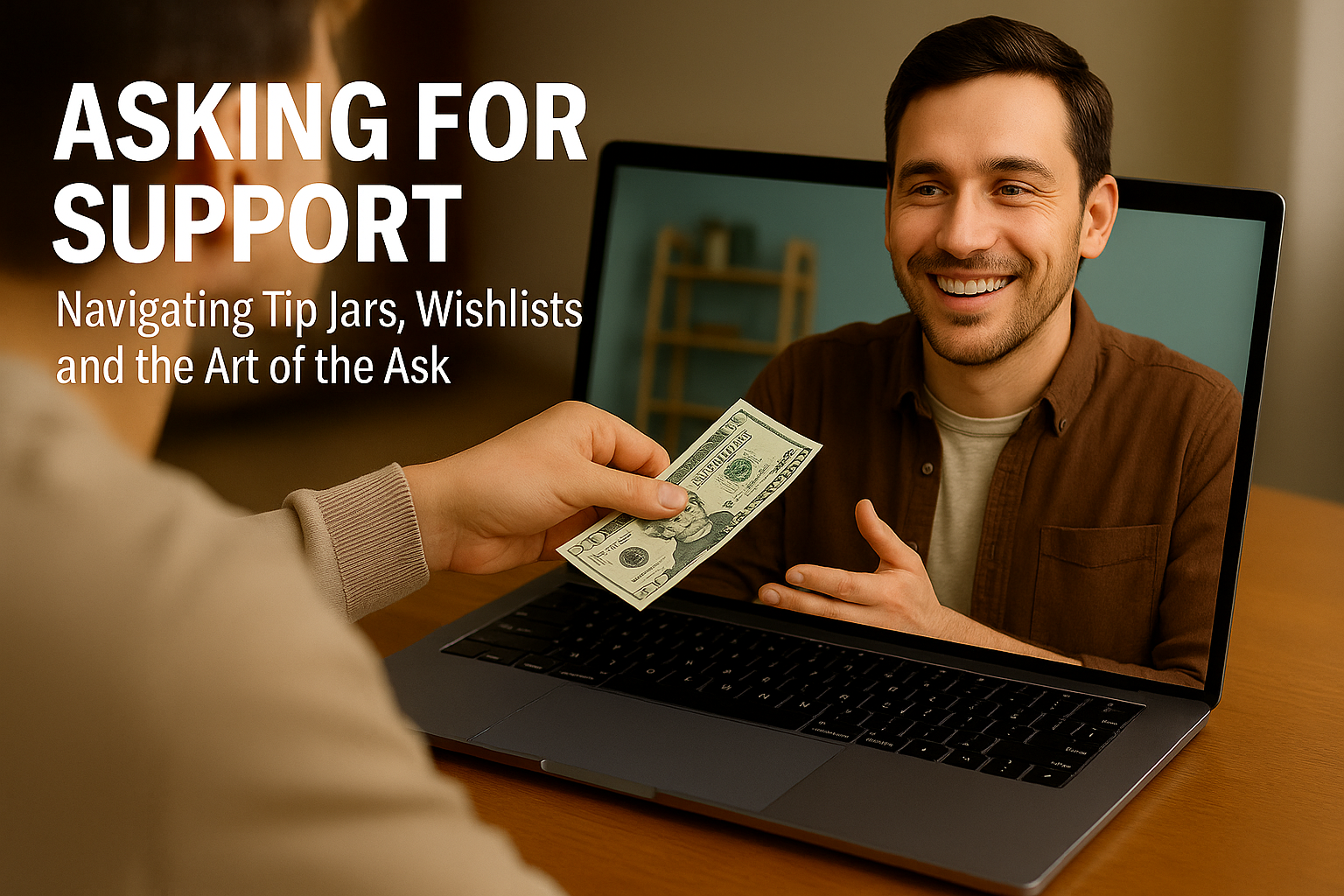Earlier today I was reading a thread in a different YouTube Support Group about whether or not to include an Amazon wishlist in your YouTube video descriptions. As many of you know I am approaching my channel as more of a ministry and so this topic is one that I have researched quite a bit. What follows is a brief essay with some thoughts to consider.
🧠 WHY THIS CONVERSATION MATTERS
On the surface, that thread was talking about Amazon wishlists and tipping links. But underneath, I see the thread as about more. I think it’s about something deeper — something that speaks to how we relate to our audience as creators.
➡️ Trust: What does asking for support say about the relationship between you and your viewers? Are you inviting people into something they care about, or are you creating a dynamic where they feel obligated or put off?
➡️ Perceived authenticity: Is the ask consistent with the tone, goals, and message of your content? Or does it feel like a disconnect — like a gear shift that doesn’t match the rhythm of your channel?
➡️ Timing and tone: When and how are you asking? Are you leading with the ask, or does it come naturally after you've provided significant value? Are you expressing gratitude and humility, or does it feel like a transaction?
These aren’t just logistical questions — they’re relational ones. And every content creator will wrestle with them eventually, especially those of us trying to build channels rooted in purpose, service, and impact rather than just numbers.
This is why the conversation matters. Because the way we ask — or choose not to — says a lot about the kind of community we’re building, and the kind of creator we’re becoming.
⚖️ VALUE VS. ASK: THE UNSPOKEN RATIO
This might be the most important point of all: the value-to-ask ratio matters.
At its core, this idea is about balance. Viewers come to a video hoping to learn something, feel something, or be entertained — and when the creators “asking for support” overshadows that, it can create friction.
Imagine a 5-minute video where 90 seconds of that video is spent asking for support. That’s 30% of the video devoted to the ask — and for most viewers, that ratio feels disproportionate. It sends the message (whether intended or not) that support might matter more than service.
Now picture a 30-minute video that offers thoughtful teaching, helpful examples, and a compelling message. Then, near the end, the creator casually says:
"Before I go, if you're looking for ways to support the channel, there are a few links in the description. And of course, liking and sharing really helps."
That’s a completely different experience. It feels earned. It respects the viewer’s time and attention. It recognizes that support is something meaningful viewers might want to do — but it doesn’t pressure them into doing it.
The key here isn’t about exact time stamps — it’s about proportionality and posture. When the value far outweighs the ask, the ask can feel like an invitation. When the ask outweighs the value, it feels like a transaction. Or worse — a plea.
It’s not that creators shouldn’t ask for support. It’s that the ask should feel like a natural continuation of the value already given — not a shortcut to compensation.
And when we get that ratio right? It builds trust, strengthens connection, and turns casual viewers into active supporters.
🧭 THE NICHE & AUDIENCE FACTOR
What niche you’re in — and who you’re serving — plays a huge role in how your ask lands. It’s not just about what you’re offering, but how your audience interprets your role as a creator.
✅ In a ministry, teaching, or cause-driven channel, viewers are often aware that the creator is offering time, energy, and expertise as a form of service. Support links in these contexts can feel natural — even expected. A tip jar or wishlist doesn’t feel like a handout; it feels like participation. It’s a way for the audience to say, “I believe in this mission, and I want to help carry it forward.”
⚠️ But in a financial, business, or wealth-building channel — especially one where the creator is teaching monetization strategies or sharing personal success stories — the same ask can feel completely different. To some viewers, it can come across as inconsistent or even opportunistic: “If this strategy made you six figures, why are you asking me to buy you coffee?”
🎯 Audience expectations are shaped not only by your content, but by your tone, backstory, and the perceived power dynamic. A small, emerging channel with a transparent “here’s how you can support me while I grow” message will land differently than a polished brand with a million views and a monetization-heavy tone.
It’s also worth considering how culture and context affect audience behavior. Some audiences are used to creators offering “value-first, support-optional” models. Others are more skeptical of any request that even hints at fundraising.
That’s why clarity of intent matters so much. When your support options are clearly tied to your mission and your audience’s values, they don’t feel like asks — they feel like alignment.
In short:
➤ Know your audience.
➤ Understand their expectations.
➤ Make sure your invitation to support feels consistent with the story you're telling and the value you’re delivering.
💬 HOW YOU SAY IT MATTERS MORE THAN WHAT YOU SAY
The way you frame your ask can either invite trust or erode it. Asking for support doesn’t have to feel cringey or awkward — but it easily can if the tone, timing, or delivery feel off.
It tends to go sideways when:
❌ The ask is front-loaded, hitting the viewer before they’ve even received anything of value.
❌ It comes across as entitled, as if support is owed rather than appreciated.
❌ It feels emotionally manipulative, wrapped in guilt or language like, “If you really care…”
❌ It interrupts the viewer’s journey rather than extending it.
Now contrast that with the approach that earns trust:
✅ A short, optional mention near the end of the video — right when loyal viewers are most likely to stick around and most inclined to support.
✅ Framing the ask as one of several ways people can show support — not the only one.
✅ Spoken with gratitude and humility, not pressure or expectation. Something like:
“If you’re looking for ways to support the channel, I’ve included a few links in the description. But honestly, just liking, commenting, or sharing helps so much.”
The difference here is subtle — but powerful. One version says, “I need you to help me.” The other says, “I appreciate you being here, and if you feel led to support, here’s how.”
And this principle applies across the board — whether it’s an Amazon wishlist, “Buy Me a Coffee,” Patreon, affiliate links, or something else entirely. The content of the ask matters less than the spirit in which it’s delivered.
Support should always feel like an invitation — not a transaction.
🧩 THE BIGGER QUESTION: WHAT ARE YOU BUILDING?
At the end of the day, this entire conversation isn’t really about Amazon wishlists, tip jars, or monetization strategies. It’s about something much deeper: the kind of relationship you’re building with your audience, and the kind of creator you’re choosing to be.
Support will always follow trust more than tactics. People give to creators they believe in — creators who show up consistently, deliver meaningful value, and invite others into something bigger than themselves.
But people also notice when something feels off. They notice when a creator starts asking before they’ve done the work of earning trust. They notice when the tone shifts from service to self-focus. And once that trust is strained, it’s hard to rebuild.
That’s why this isn’t just a practical question — it’s a directional one.
“What kind of experience am I creating for the people who choose to give me their attention?”
That one question reframes everything.
It moves the conversation from:
“How can I get support?”
to
“How can I serve so well that support becomes the natural byproduct?”
So maybe the better question for all of us isn’t, “Can I ask for support?” but rather:
“Have I created enough value — and built enough trust — for this ask to feel like a natural next step?”
If the answer is yes, your audience won’t just tolerate the ask — they’ll welcome it.
If the answer is no, it’s not a failure. It’s simply feedback — a chance to grow deeper roots before expecting fruit.
Because in the end, the strongest creator-audience relationships aren’t built on pressure… they’re built on trust, value, and shared purpose.
🧵 CLOSING THOUGHTS
This essay was born from a conversation — not a policy, a formula, or a playbook. And that’s fitting, because these decisions about support, value, and trust are rarely black and white.
Every creator is building something unique. What feels right for one channel may feel out of place for another. What resonates with one audience might miss the mark with another. That’s why these conversations matter — because they help us build our channels with intention, not just momentum.
Yes, creators are allowed to ask for support.
Yes, tools like wishlists, tip jars, and affiliate links are valid ways to invite that support.
But how we ask — and when — will always matter more than what we ask for.
The heart behind the ask is what shapes the experience. When we lead with clarity, humility, and a desire to serve, our communities respond with trust, appreciation, and — often — support that’s freely and gladly given.
So let’s keep creating from a place of generosity. Let’s keep our focus on what we’re building, not just what we’re hoping to receive. And let’s never forget that behind every subscriber, comment, and click is a real person choosing to spend their time with us.
That kind of trust is worth honoring — every single time.
— George


